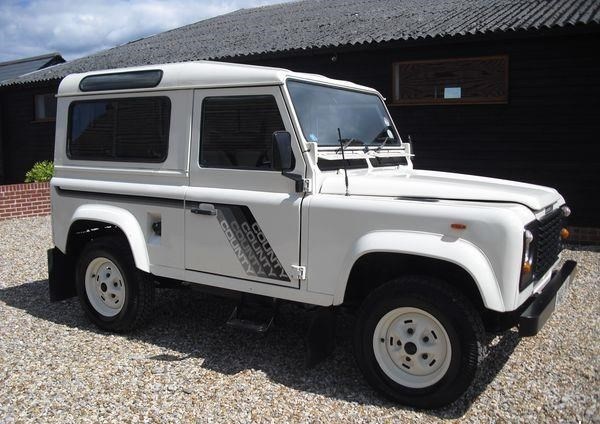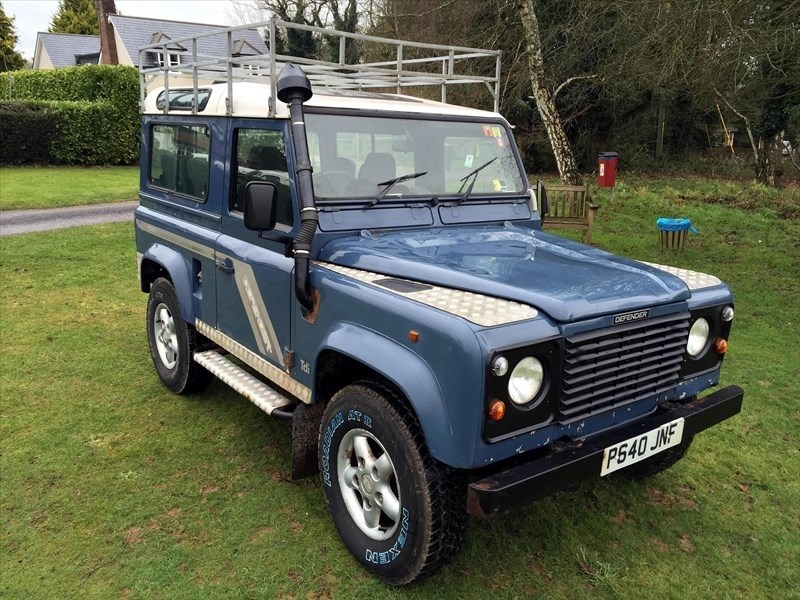With production ending this year, now is the perfect time to put this classic mud-plugger under the spotlight...
Driving a Land Rover is always an experience, and the short wheelbase 90 – or Defender as it became in 1990 – is a classic example of the genre. Generally speaking, the earlier the model the more agricultural it feels on the road, but even the very latest cars are hardly paragons of comfort or refinement. That’s not really the point of these vehicles, of course, as the Landie was designed to offer long-lasting go-anywhere ability rather than cosset its occupants. But it does mean that you need to try one before you take the plunge as they most definitely aren’t for everyone. Indeed, on first acquaintance you might be forgiven for thinking that it was designed to be as challenging as possible, what with its hefty controls and poor driving position. You sit very upright for one thing, with limited seat adjustability, and the narrowness of the cabin means that banging you’re elbow on the driver’s door is almost inevitable as you twirl the wheel. The chunky pedals – ideally spaced for driving in wellies – feel weighty and the gearlever needs a firm hand, although it has to be said, there’s a satisfyingly mechanical feel to all the controls. Oh yes, and then there’s the ride and handling. The former is bouncy at just about any speed while any hint of over-enthusiasm – especially in the wet – will soon have the chunky tyres relinquishing their grip on the road. All of which forces a more sedate driving style, which if nothing else helps limit the intrusive levels of road, wind, and engine noise. You’ll probably not be surprised to find that things are pretty crude in the cabin too, with basic materials and construction and little in the way of kit on most models. So it’s not much fun then? Well, actually for many people it’s just the opposite. Make no mistake, allowances need to be made but the Landie is incredibly practical, and it’s durability and off-road credentials are almost unmatched. Approach it with an open mind, then, and it could be the most fun you’ve had behind the wheel in ages.
VITAL STATISTICS
Land Rover 90 TDi
Engine 2495cc/4-cyl/OHC
Power 85bhp@4000rpm
Torque 150lb ft@1800rpm
Top speed 74mph
0-60mph 22.3secs
Economy 22mpg
Gearbox 5-speed manual
WHAT TO LOOK FOR
BODYWORK & CHASSIS
The place to start with these is underneath, as problems there are going to be the most expensive. Major chassis or bulkhead corrosion can be sorted but replacement can be upwards of £4000 and £3000 respectively, so check carefully. A car that’s a patchwork of welding beneath is probably best dismissed, and it’s worth bearing in mind that farmyard grot can accelerate corrosion so be wary of mud-laden examples. Areas to check include the body mounting points, outriggers, rear crossmember, and footwells. Watch for DIY bodgery too.
Don’t be alarmed by the fairly dreadful levels of panel fit and the large gaps– that’s normal – but you need to keep any eye out for galvanic corrosion in the aluminium body panels, the door bottoms especially, but replacements are plentiful and generally cheap. Steel doors were fitted from 2004 and don’t appear especially rust-prone, but all need checking for signs of worn door and tailgate hinges. Excessive play is common and causes water leaks past the seals but it’s a cheap and easy DIY fix. A few dents and scrapes add to the character but the Landie is very easy to titivate with later parts and snorkels, chequer plating etc.
ENGINE
Various engines have been fitted over the years, with the earliest diesels proving robust and easy to repair, if entirely lacking in performance or refinement. Units badged 200Tdi and 300Tdi were used from 1990 to 1994, and are both sought after and reliable. The camshafts are belt driven with replacement needed every six years or 72,000 miles but they rarely break and won’t damage anything if they do. The five-cylinder 2.5-litre Td5 from 1998 added electronic complexity and needs proper diagnostic kit making it pricier to fix, so you’re best off with a Tdi if possible. Ford’s Duratorq (the ‘Puma’ engine) unit was fitted from 2007 and should be trouble-free if serviced properly. Both of the later units use cam chains rather than belts.
Even diesel units weren’t exactly thrifty, but there’s always the option of the 3.5-litre V8 that was available early on. You need to watch for head gasket problems and cam wear, though, and whichever engine you choose it’s worth checking for signs of oil and coolant leaks and evidence of neglect. Excessive smoke from turbocharged engines should ring alarm bells.
Ensure you know what engine has been fitted as swaps are common. Many were simply run into the ground, although replacement engines aren’t hard to find and can be an economical option if the rest is sound. When it comes to mechanical parts, be wary of the cheap and inferior pattern stuff that exists – Land Rover OEM items are normally best according to specialists.
TRANSMISSION
Oil leaks from the gearbox and four-wheel drive hardware aren’t uncommon, and it’s important to ensure it’s all operating as it should. Expect it to be noisy and clunky, but anything too obstructive or signs of badly worn synchromesh will need further investigation. Amateur tinkering with the differential locks isn’t advisable so get the system checked by a specialist if you’re unsure. Wear in driveshaft and prop shaft joints are common issues, although clutch replacement is fairly inexpensive.
STEERING & SUSPENSION
Steering and suspension can take a pounding so check carefully for wear and tear, and lack of maintenance. Tired bushes and joints are the most common problems, and it’s worth checking for rot around the coil spring mountings. The steering box and PAS hydraulics can leak but overhauling the running gear is straightforward. Braking-wise, early models got disc and drums with discs all-round and ABS later. Chunky alloy wheels are popular with the urban warriors and just need checking for damage and corrosion.
INTERIORS
Interiors are a basic affair with fairly dire build quality, but damaged trim and non-functioning electrics are easy to sort. Leaks from the heater aren’t unusual, and while you might want to avoid anything too battered at least replacement parts are in plentiful supply.
OUR VERDICT
Frankly, this is going to be a car that you either love or hate. The verdict, then, depends which side of the fence you’re on but there’s no doubting it has a very unique appeal. Make sure you can live with the driving experience, but we’ll probably never see the like again, and that makes it a pretty special thing.


